CAA News Today
New Members and Officers at the May Board Meeting
posted by Christopher Howard — April 30, 2012
Newly elected members and officers of the CAA Board of Directors will join the governing body at its spring meeting, to be held on Sunday, May 6, 2012. Charged with CAA’s long-term financial stability and strategic direction, the board sets policy regarding all aspects of the organization’s activities, including publishing, the Annual Conference, awards and fellowships, advocacy, and committee procedures.
New Directors
The board welcomes four new members, who will serve from 2012 to 2016:
- Suzanne Preston Blier, professor in History of Art and Architecture and the African and African American Studies Departments at Harvard University in Cambridge, Massachusetts
- Stephanie D’Alessandro, curator of modern art at the Art Institute of Chicago in Illinois
- Gail Feigenbaum, associate director of the Getty Research Institute in Los Angeles, California
- Charles A. Wright, artist and chair of the Department of Art at Western Illinois University in Macomb
New President
Anne Collins Goodyear, assistant curator of prints and drawings at the National Portrait Gallery, Smithsonian Institution, in Washington DC, will serve as the organization’s next president for a two-year term, beginning May 2012.
New Officers
At its February 2012 meeting, the board elected new officers—four vice presidents and a secretary—from among its members to serve one-year terms, from May 2012 to April 2013.
- Patricia McDonnell, director of the Ulrich Museum of Art at Wichita State University in Kansas, has been reelected for a second term as vice president for external affairs
- DeWitt Godfrey, an artist and associate professor of art and art history at Colgate University in Hamilton, New York, was elected vice president for committees. Last year he served as board secretary
- Jacqueline Francis, professor of art history at California College of the Arts in San Francisco, has been named vice president for Annual Conference
- Randall C. Griffin, professor of art history at Southern Methodist University in Dallas, Texas, has been reelected vice president for publications to serve a second term
- Maria Ann Conelli, dean of the School of Visual, Media, and Performing Arts at Brooklyn College, City University of New York, has been elected secretary. She had spent the previous year as vice president for committees
CAA will publish a report on the spring board meeting later this month.
Recent Deaths in the Arts
posted by Christopher Howard — April 24, 2012
In its regular roundup of obituaries, CAA recognizes the lives and achievements of the following artists, scholars, designers, architects, photographers, curators, dealers, filmmakers, and other men and women whose work has had a significant impact on the visual arts. This month was marked by the loss of the sculptor Elizabeth Catlett, the divisive art critic Hilton Kramer, the scholar and curator John Golding, and the art dealer Donald Young.
- Cris Alexander, a portrait photographer and actor who landed a starring role in the 1944 Broadway musical On the Town, died on March 7, 2012, at the age of 92. Born in Tulsa, Oklahoma, Alexander arrived in New York in the late 1930s with dreams of stardom. He photographed Martha Graham, collaborated on satirical novels about Hollywood, and worked for Andy Warhol’s Interview magazine
- Rex Babin, an editorial cartoonist for the northern Californian newspaper the Sacramento Bee since 1999, died on March 30, 2012, age 49. Babin was known for cartoons that tackled current events with whimsy, humor, and pathos
- Toni Beauchamp, a Texan patron of the arts, passed away on March 9, 2012, at the age of 66. Beauchamp was an assistant director of Houston’s Blaffer Gallery in the 1970s and 1980s and was a proponent of the burgeoning art scene around Houston and the Chinati Foundation in Marfa, Texas. A collection of essays about Marfa’s cultural community will be released posthumously
- Eliy Belyutin, a Russian art historian and art teacher, died on February 29, 2012, at the age of 87. Belyutin attended the Moscow Art Institute, and in 1954 he founded a painting school called the New Reality that encouraged an individualistic approach to art-making
- Eleanor Callahan, a striking muse for her photographer husband, Harry Callahan, died on February 28, 2012. She was 95 years old. Eleanor Callahan was photographed throughout her sixty-three years of marriage, an arc that traced the couple’s early courtship to their family life with their daughter, Barbara. The stark, black-and-white portraits drew comparisons to Alfred Stieglitz’s famous photographs of Georgia O’Keeffe
- Elizabeth Catlett, a figurative sculptor whose art practice was rooted in social reality, passed away on April 12, 2012, at the age of 96. Catlett drew from her own experience as an African American woman and expressed a desire to make art that would empower the lives of other African Americans and appeal to a broad sweep of humanity. She moved to Mexico in the late 1940s, where she was the first woman to head the art department at the Universidad Nacional Autónoma de México in Mexico City
- John S. Chase, a prominent modern architect and the first African American to serve on the United States Commission of Fine Art in 1980, died on March 29, 2012. He was 87 years old. Chase’s notable projects include the United States embassy in Tunis, Tunisia. During his tenure on the commission, he oversaw the creation of the Vietnam War Memorial
- Sid Couchey, a comic-book artist who was a principle illustrator for the 1950s Harvey Comics characters of Richie Rich, Little Lotta, and Little Dot, died on March 11, 2012, at the age of 92. Couchey also created cartoon mascots for national drug-prevention campaigns and for the 1980 Winter Olympics on Lake Placid
- David Lee Craven, distinguished professor of art history at the University of New Mexico, died on February 11, 2012, at the age of 60. He was an expert in twentieth-century Latin American art, postwar American art, and the methodology of art history and visual culture
- Bruno Giacometti, a Swiss architect and the younger brother of the artist Alberto Giacometti, died at the age of 104 on March 21, 2012. The youngest of four children, Bruno Giacometti remembered posing as a child for his older brother’s first attempts at sculpture. In 1930 he joined the Zurich architectural firm of Karl Egender, but it was after World War II that he completed his most important works as a freelance architect, including the Swiss Pavilion at the Venice Biennale in 1952
- Jean Giraud, the French comic-book artist known as Moebius, died on March 10, 2012, at age 73. Giraud was something of a national treasure in France, beloved by artists and the general public alike. An early success was the Wild West–themed comic book, Les Adventures de Blueberry (1963). Giraud’s fantasy visions led to work in cinema: he contributed drawings to Alejandro Jodorowsky’s unfinished film Dune and to Ridley Scott’s Alien
- John Golding, a British art historian of twentieth-century art with a focus on Cubism, died on April 9, 2012, at the age of 82. Golding taught at the Courtauld Institute of Art in London, from which he also graduated, and was the head of the painting school at the Royal College of Art. He curated two seminal exhibitions for Tate Modern, Picasso: Sculptor/Painter (1994) and Matisse/Picasso (2002), and in his later years focused on his own abstract painting
- John Griffiths, a British illustrator who designed a series of covers for Penguin paperbacks in the 1950s and 1960s, passed away on March 13, 2012. He was 85 years old. Trained as a painter and printmaker, Griffiths applied his technique to darkly outlined, hand-drawn covers that were beloved by readers as a companion to the text inside
- Bernard Otto Gruenke, a stained-glass artist who created one of the first faceted glass windows in America, passed away on March 21, 2012. He was 99. Gruenke attended the Corcoran Art School in Washington, DC, and created stained-glass windows for churches, synagogues, and theaters throughout the country. For many years he served as the vice president of the Stained Glass Association of America
- Albert Hadley, an interior decorator for high society on the East Coast, died on March 30, 2012, at the age of 91. Hadley and the socialite-decorator Sister Parish founded their company, Parish-Hadley, in 1962. Important commissions for the pair included the library at Brooke Astor’s Park Avenue home and the breakfast room of the Kennedy White House
- Francis Hewlett, a British sculptor and painter who was head of painting at the Falmouth School of Art in Cornwall, died on March 19, 2012. He was 81 years old. Hewlett studied at the Slade School of Art in London and in the 1960s was inspired by Pop art to make large-scale ceramic sculptures of hands and other body parts
- Robert Hoozee, the director of the Museum of Fine Arts in Ghent, Belgium, and a scholar of nineteenth-century British art, died on February 21, 2012, at the age of 62. Hoozee’s last exhibition at the museum was the critically acclaimed British Vision (2007), which offered a radical take on the history of British art, with an emphasis on underrepresented artists such as Stanley Spencer
- Thomas Kinkade, a populist artist and the self-proclaimed “painter of light,” died on April 6, 2012, at age 54. His early influences were Norman Rockwell and Walt Disney. Kinkade believed that his artistic ambition was one that he shared with Disney: to inspire happiness through the dissemination of rosy-toned images of a bucolic American past
- Hilton Kramer, the controversial art critic who championed his particular definition of modernism, died on March 27, 2012. He was 84 years old. Kramer’s career was kick-started by his impassioned rebuttal to Harold Rosenberg’s psychoanalytic theory of Abstract Expressionism. Kramer began writing regularly for Arts Digest (later renamed Arts) and was chief art critic for the New York Times before founding the decidedly more conservative New Criterion in 1982
- Sergio Larrain, a Chilean photographer and member of the Magnum Photos agency, passed away on February 7, 2012, at the age of 80. Larrain often captured his subjects in a “state of grace”: children playing in the street, a portrait of poet Pablo Neruda’s house, and a series of accidental photographs of a couple outside the Notre Dame Cathedral that became the inspiration for Julio Cortozar’s short story “Blow-Up”
- Mauricio Lasansky, an Argentine printmaker and draftsman remembered for his series The Nazi Drawings, died on April 2, 2012, at the age of 97. Lasansky established the printmaking department at the University of Iowa and bolstered the school’s reputation as a center for graphic arts. His attention to simple art materials (pencil, paper, water washes) and weighty subject matter singled him out as an innovator in his field
- Simon Marsden, a British photographer noted for his Romantic subject matter and an attraction to the spectral dimensions of architecture and landscapes, died on January 22, 2012, at the age of 63., A keen critic of consumer culture and other ills of modernity, Marsden published twelve books of photography and inspired album-cover art by the rock band U2
- Ralph McQuarrie, a conceptual designer who worked on the Star Wars trilogy as a primary illustrator and set designer, died on March 3, 2012, at the age of 82. McQuarrie’s rich sense of science fiction and fantasy aided him in subsequent work on the Battlestar Galactica television series and on the films E.T. the Extra-Terrestrial and Cocoon, for which he won an Academy Award
- Brett Miller, the general counsel for the Barnes Foundation in Philadelphia, died on April 14, 2012, aged 47. After joining the Barnes in 2009, Miller played a key role in the foundation’s move from Merion, Pennsylvania, to the Benjamin Franklin Parkway in Philadelphia. His background as a curator made him a strong candidate for the high-profile position at the foundation
- Jackson L. Narcomey, a Native American painter and printmaker and a member of the Muskogee Creek tribe, passed away on March 22, 2012, at the age of 70. Born in Oklahoma, Narcomey came to prominence in his community during the late 1960s for his oil paintings of tribal legends
- Christopher Powell, a British architectural historian noted for his work on the architecture of Wales, passed away on March 9, 2012, at age 70. In addition to his work as a professor at the Welsh School of Architecture, Powell established the Construction History Society and served as editor of the society’s academic journal
- Kenneth Price, an artist who helped bridge the gap between ceramics and sculpture with his shockingly vibrant clay vessels, died at his home in Taos, New Mexico, on February 24, 2012. He was 77 years old. A native of Los Angeles, Price had several high profile shows in the 1960s at the Ferus Gallery, famed for its stable of Pop artists. A retrospective at the Los Angeles County Museum of Art is scheduled to open in fall 2012
- Leonard Rosoman, a British painter, graphic artist, and longtime professor at the Royal College of Art in London, died on February 21, 2012, at the age of 98. During World War II he was appointed official war artist, an assignment that dispatched him to dangerous scenes of conflict to record what he saw. Rosoman’s work as a visual artist extended to exhibition design, most notably working on the Sergei Diaghilev exhibition in London in 1954
- Al Ross, a cartoonist at the New Yorker for over sixty years, passed away on March 25, 2012. He was 100 years old. Born in Romania, Ross began his career in the 1930s working alongside his four brothers at the Saturday Evening Post and Collier’s before joining the New Yorker in 1937. His arch sensibility and educated silliness were illustrated by sketchy line drawings of arguing couples, animals, therapists, and other denizens of the magazine’s cartoon universe.
- Paul Rudall, a British artist, teacher, and illustrator, died on February 10, 2012, at the age of 91. Rudall served as the head art teacher at Chiswick Grammar School and Dudley Grammar School, where he influenced several generations of students. Since retiring from teaching in 1980, he lived in Bath, England and exhibited his oil paintings across the United Kingdom and in Germany
- Charlie Stagg, an eccentric Texan artist, died on February 20, 2012, at the age of 72. Stagg attended Tyler School of Art in Philadelphia but chose to live and work as an outsider artist in the A. V. Stagg Art Studio and Wildlife Preserve, a “folk-art style, glass bottle and cement home,” where visitors were always welcome
- Anita Steckel, a painter and feminist activist who worked under the radar for many decades, died on March 16, 2012, at the age of 82. Steckel was a self-proclaimed enemy of “good taste in art” who fought for the rights of women artists. She faced criticism and censorship for a series of erotic paintings that she exhibited in 1973
- Eduard Steinberg, a Paris-based, Russian avant-garde painter who created mystical, geometric abstractions, died on March 28, 2012, at the age of 75. His childhood home in Tarus, a town near Moscow, was a meeting ground for artists and poets who were persecuted during Stalin’s regime. Steinberg saw his work as a synthesis of Kazimir Malevich’s Suprematism, Russian icon painting, and personal religious belief
- Barry Walker, a former curator of prints and drawings at the Museum of Fine Arts in Houston, Texas, died on April 18, 2012, at the age of 67. Walker joined the museum in 1991 and was instrumental in establishing the print and drawing department and boosting the museum’s modern and contemporary art collection. Popular shows he organized at the museum include Alice Neel: Painted Truths (2010) and Singular Multiples: The Peter Blum Edition Archive, 1980–1994 (2006)
- Eric Watson, a British rock-and-roll photographer with an artful eye, noted for his work with the Pet Shop Boys, died on March 18, 2012, at the age of 56. In the 1970s and 1980s Watson’s images were published in the magazine Smash Hits, and he also directed music videos influenced by art photography, such as Robert Mapplethorpe’s. Watson’s work, transcending its original pop origins, is now in the collection of the Victoria and Albert Museum and the National Portrait Gallery, both in London
- Isabel Brown Wilson, a Texan philanthropist who was a prominent figure in Houston’s art scene, died on March 27, 2012, at the age of 80. Wilson was a life trustee and chairman of the board of the Museum of Fine Arts in Houston. Through her family’s charitable trust, the Brown Foundation, she helped to raise the museum’s endowment, to enlarge the collection, and to ensure the institution’s future stability
- Donald Young, a noted Chicagoan art dealer, passed away on April 16, 2012, at the age of 69. Born in England, Young lived in Paris and New York before opening the Young-Hoffman Gallery, with Rhona Hoffman, in Chicago in 1976. Their gallery championed Conceptual and Minimal art; when it was later renamed the Donald Young Gallery, he showed video art by Bruce Nauman, Bill Viola, and Rodney Graham
Read all past obituaries in the arts in CAA News, which include special texts written for CAA. Please send links to published obituaries to Christopher Howard, CAA managing editor, for the May listing.
Revised Procedures for Task Forces
posted by Christopher Howard — April 23, 2012
At its February meeting, the CAA Board of Directors approved a revised statement on the formation of task forces. The Revised Procedures for Task Forces (2012) added the step of the Executive Committee’s review and prioritization of all task-force proposals prior to their presentation to the board for discussion and approval. The revision will ensure the streamlining of the task-force approval process.
The board periodically establishes task forces to gather information and provide recommendations concerning areas of importance to the organization. Any CAA member may suggest the formation of a task force by sending a request to develop a proposal to the board president or to the chair of a standing committee. Once the board adopts a resolution establishing the task force, the task-force chair will work with the executive director to determine staff involvement, frequency of meetings, and division of responsibilities for the team. The task force will prepare a report based on its research to the board and may also recommend additional work to be undertaken to complete its task.
Solo Exhibitions by Artist Members
posted by CAA — April 22, 2012
See when and where CAA members are exhibiting their art, and view images of their work.
Solo Exhibitions by Artist Members is published every two months: in February, April, June, August, October, and December. To learn more about submitting a listing, please follow the instructions on the main Member News page.
April 2012
Abroad
Sue Johnson. Pitt Rivers Museum, University of Oxford, Oxford, England, United Kingdom, January 24–June 10, 2012. The Nature of Curious Objects: Sue Johnson’s Paper Museum. Painting.
Joan Marie Kelly. Visual Arts Gallery, Habitat Center, New Delhi, India, April 11–17, 2012. Initial Encounters. Painting and drawing.
Mid-Atlantic
Margaret Murphy. Kresge Foundation Gallery, Ramapo College of New Jersey, Mahwah, New Jersey, March 28–May 2, 2012. Margaret Murphy, A Ten-Year Survey; Decoding the Marketplace: Coupons, Dollar Stores, and eBay. Painting.
Margaret Murphy. Harold B. Lemmerman Gallery, New Jersey City University, Hepburn Hall, Jersey City, New Jersey, January 30–March 7, 2012. Margaret Murphy, A Ten-Year Survey; Decoding the Marketplace: Coupons, Dollar Stores, and eBay. Painting.
Midwest
Michelle Grabner. Green Gallery, Milwaukee, Wisconsin, January 21–February 26, 2012. Cottage Work. Painting.
Julie Green. UNO Art Gallery, University of Nebraska, Omaha, Nebraska, January 13–February 8, 2012. The Last Supper. Painted ceramic plates and video.
Sharon Louden. Burnet Gallery, Le Méridien Chambers, Minneapolis, Minnesota, March 1–May 6, 2012. Movement and Gesture. Painting, drawing, sculpture, and animation.
Northeast
Ellen Carey. Nina Freudenheim Gallery, Buffalo, New York, March 3–April 11, 2012. Struck by Light. Photography.
Nayda Collazo-Llorens. LMAKprojects, New York, March 16–April 22, 2012. Across Doom Hopes the Guiding Fever. Drawing.
Janet Goldner. Corridor Gallery, Interchurch Center, New York, March 15–April 13, 2012. i ni ce, thank you, merci. Sculpture.
Eve Ingalls. SOHO20 Chelsea Gallery, New York, February 28–March 24, 2012. Out of Place and Time. Sculpture.
Debra Ramsay. Blank Space Gallery, New York, April 19–May 19, 2012. Desire Lines. Painting.
Linda Stein. Flomenhaft Gallery, New York, May 17–June 23, 2012. The Fluidity of Gender: Sculpture by Linda Stein. Sculpture.
Marianne Weil. Kouros Gallery, New York, May 3–31, 2012. Fusion: Glass and Bronze. Sculpture.
South
Leigh-Ann Pahapill. Cornell Fine Arts Museum, Rollins College, Winter Park, Florida, January 28–May 13, 2012. Likewise, as technical experts, but not (at all) by way of culture. Installation.
West
Michael Darmody. New Mexico Arts Centennial Project Space, Santa Fe, New Mexico, January 13–February 17, 2012. House of Cards. Installation.
Gerit Grimm. Long Beach Museum of Art, Long Beach, California, March 15–July 8, 2012. Gerit Grimm: Beyond the Figurine, Contemporary Inspirations from the Museum’s Collection. Ceramic sculpture.
Ellen Mueller. Pueblo Fine Art Gallery, Colorado State University, Pueblo, Colorado, March 9–April 6, 2012. Ladders in the Desert. Video, photography, and installation.
Olga Ponomarenko. 825 Gallery, Los Angeles Art Association, Los Angeles, California, March 10–April 2, 2012. Romantic Punks. Painting.
Ruth Weisberg. Jack Rutberg Fine Arts, Los Angeles, California, February 18–June 30, 2012. Ruth Weisberg: Now & Then. Painting, drawing, and printmaking.
Edie Winograde. Robischon Gallery, Denver, Colorado, March 29–May 5, 2012. Appropriated Histories: Recent and Past Photographs. Photography.
Angela Young. Gallery 100, Tempe Center, Herberger Institute for Design and the Arts, Arizona State University, Tempe, Arizona, April 23–27, 2012. Human Nature. Printmaking and drawing.
Report on the CAA International Travel Grant Program
posted by Janet Landay, Program Manager, Fair Use Initiative — April 18, 2012
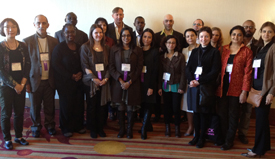 Janet Landay is project manager of the CAA International Travel Grant Program.
Janet Landay is project manager of the CAA International Travel Grant Program.
Last February, twenty art historians and curators from eighteen countries around the world attended the 2012 Annual Conference in Los Angeles through the CAA International Travel Grant Program, a new initiative that was generously funded by the Getty Foundation. For many grant recipients, this visit was their first to the United States, and for most of them it was their first time at the CAA conference.
By coincidence, on the conference’s opening day, the Los Angeles Convention Center held two swearing-in ceremonies for twenty thousand new citizens and their guests, welcoming people from several nations to the US. Indeed, the CAA group felt like a miniature United Nations, and it was equally moving to see colleagues arrive at the conference from countries around the world. Participants included: Ganna Rudyck (Ukraine), Irena Kossowska (Poland), Pavlina Morganová (Czech Republic), Dóra Sallay and Gyöngyvér Horváth (Hungary), Cristian Nae (Romania), Daniel Premerl (Croatia), Malvina Rousseva (Bulgaria), Salam Atta Sabri (Iraq), Angela Harutyunyan (Lebanon), Nadhra Shahbaz Naeem Khan (Pakistan), Parul Pandya Dhar (India), Jageth Weerasinghe (Sri Lanka), Shao-Chien Tseng (Taiwan), Olabisi Silva (Nigeria), Didier Houenoude (Benin), Jean Celestin Ky (Burkina Faso), Federico Freschi and Judy Peter (South Africa), and Rosa Gabriella de Castro Gonçalves (Brazil). Read more about the recipients, their home institutions, and their areas of interest.
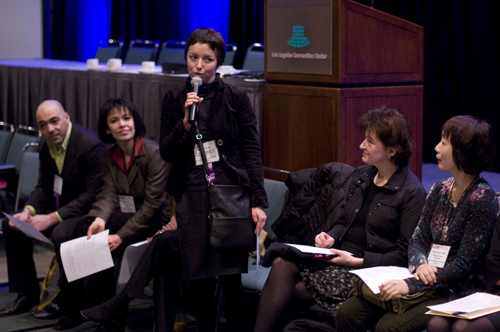 The purpose of this initiative was to encourage greater participation from countries not well represented at CAA’s Annual Conference in order to bring a more diverse and global perspective to the study of art history. The Getty travel-grant participants, as they became known, were selected by a jury of CAA members from among 150 applicants based on three general criteria: all had to be professors of art history, artists who teach art history, or museum curators with advanced degrees in art or art history; they had to work in a country where art history is an emerging discipline; and they needed to explain how attending the conference would significantly support or strengthen their work.
The purpose of this initiative was to encourage greater participation from countries not well represented at CAA’s Annual Conference in order to bring a more diverse and global perspective to the study of art history. The Getty travel-grant participants, as they became known, were selected by a jury of CAA members from among 150 applicants based on three general criteria: all had to be professors of art history, artists who teach art history, or museum curators with advanced degrees in art or art history; they had to work in a country where art history is an emerging discipline; and they needed to explain how attending the conference would significantly support or strengthen their work.
To welcome the participants and to ensure that they got the most out of the conference’s abundant offerings, members of CAA’s International Committee and representatives from the National Committee for the History of Art (NCHA) volunteered to act as hosts. CAA warmly thanks these members for their service as hosts: Ann Albritton, Frederick M. Asher (NCHA chair), Kathryn Brown, Nicola M. Courtright, Diane Derr, Stephanie Dickey, Thomas W. Gaehtgens, Paul B. Jaskot, Geraldine A. Johnson, Jennifer Milam (International Committee chair), Steven Nelson, Nada Shabout, and Beth A. Steffel.
 This wonderful aspect of the program revolved around informal dinners, lunches, and drinks, in which both participants and hosts could trade stories and share information about the ins and outs of practicing art history in their respective countries. Two roundtable meetings brought everyone together to meet CAA staff, providing opportunities for assessment and reflection on the various aspects of the conference program. Equally stimulating were the friendships made among the participants, as they learned about each other and discovered shared interests and challenges. Now, nearly two months later, a number of grant recipients have already begun to collaborate on research and teaching projects, with ambitious plans in the works.
This wonderful aspect of the program revolved around informal dinners, lunches, and drinks, in which both participants and hosts could trade stories and share information about the ins and outs of practicing art history in their respective countries. Two roundtable meetings brought everyone together to meet CAA staff, providing opportunities for assessment and reflection on the various aspects of the conference program. Equally stimulating were the friendships made among the participants, as they learned about each other and discovered shared interests and challenges. Now, nearly two months later, a number of grant recipients have already begun to collaborate on research and teaching projects, with ambitious plans in the works.
In the coming months, CAA will publish online interviews with several participants and report on their collaborative work as it unfolds. Stay tuned to future issues of CAA News for these special announcements.
Top image: Participants in the CAA International Travel Grant Programs (from left): Shao-Chien Tseng, Salam Atta Sabri, Olabisi Silva, Jean Celestin Ky, Pavlina Morganová, Dóra Sallay, Federico Freschi, Judy Peter, Didier Houenoude, Rosa Gabriella de Castro Gonçalves, Daniel Premerl, Angela Harutyunyan, Malvina Rousseva, Cristian Nae, Ganna Rudyck, Irena Kossowska, Parul Pandya Dhar, Jageth Weerasinghe, and Nadhra Shahbaz Naeem Khan; Gyöngyvér Horváth is not pictured (photograph by Katie Underwood and provided by the Getty Foundation)
Middle image: Ganna Rudyck from Ukraine introduces herself to fellow grant recipients (photograph by Bradley Marks)
Bottom image: Among the grant recipients were (from left): Shao-Chien Tseng from Taiwan, Didier Houenoude from Benin, and Jean Celestin Ky from Burkina Faso (photograph by Bradley Marks)
2012 National Humanities Alliance Annual Meeting
posted by Linda Downs — April 18, 2012
 Linda Downs is CAA executive director, and Anne Collins Goodyear, associate curator of prints and drawings at the National Portrait Gallery, Smithsonian Institution, is the incoming president of the CAA Board of Directors.
Linda Downs is CAA executive director, and Anne Collins Goodyear, associate curator of prints and drawings at the National Portrait Gallery, Smithsonian Institution, is the incoming president of the CAA Board of Directors.
Anne Collins Goodyear and Linda Downs attended a day of meetings and panel discussions presented by the National Humanities Alliance (NHA). The event, held on March 19, 2012, in Washington, DC, stressed the practical significance of the humanities for a democratic society and highlighted the important contributions of recent research projects. It also helped prepare participants for Humanities Advocacy Day, taking place on Capitol Hill the following day. CAA is a member of NHA, which advocates federal funding of the humanities. In addition to its annual meeting, NHA organizes Humanities Advocacy Day, which brings critical information to participants and prepares them for congressional visits to support the National Endowment for the Humanities, the National Historical Publications and Records Commission, the Fulbright Program, the Institute for Museum and Library Services, and numerous Department of Education programs in the humanities.
 The first panel introduced a wide variety of historical research projects, such as the Dictionary of American Regional English, which took ten years to develop, according to its senior editor, Luanne von Schneidemesser, and now has a broad value to researchers of all kinds, from linguists to forensic detectives. Kenneth Price, a professor of literature at the University of Nebraska in Lincoln, discussed the Walt Whitman Archive, an online resource of thousands of documents related to the poet’s writings, and Colin Gordon, a history scholar at the University of Iowa, talked about his recent book, Mapping Decline: St. Louis and the Fate of the American City. Finally, Connie Lester, a professor of history at the University of Central Florida, presented the Regional Initiative for Collecting the History, Experiences, and Stories, an oral-history program that is taking place in her state. Each project demonstrated its uses to both academic and public researchers.
The first panel introduced a wide variety of historical research projects, such as the Dictionary of American Regional English, which took ten years to develop, according to its senior editor, Luanne von Schneidemesser, and now has a broad value to researchers of all kinds, from linguists to forensic detectives. Kenneth Price, a professor of literature at the University of Nebraska in Lincoln, discussed the Walt Whitman Archive, an online resource of thousands of documents related to the poet’s writings, and Colin Gordon, a history scholar at the University of Iowa, talked about his recent book, Mapping Decline: St. Louis and the Fate of the American City. Finally, Connie Lester, a professor of history at the University of Central Florida, presented the Regional Initiative for Collecting the History, Experiences, and Stories, an oral-history program that is taking place in her state. Each project demonstrated its uses to both academic and public researchers.
Hunter Rawlings, president of the Association of American Universities, led a second panel that focused on “The Role of the Humanities in Undergraduate Education,” offering a historical case study of James Madison to illustrate the value of prolonged study in the humanities as a means to cultivate flexible and cohesive thinking. Madison studied the classics and philosophy at New Jersey College (later renamed Princeton University). After graduation, having no specific profession or direction, he moved back home with his parents and asked the president of the college if he could continue studying under his tutelage, in effect becoming the first unofficial graduate student of the college. Madison eventually put his academic background to good use when he became the primary author of the Bill of Rights, adopted by the House of Representatives in 1789, and was later elected the fourth president of the United States. Rawlings stressed that liberty and learning are intrinsic to the humanities, noting that countries with autocratic political systems can have successful science and math curricula but that the arts and the humanities require freedom of expression to flourish.
 The panel’s second speaker, Raynard Kington, president of Grinnell College and acting director of the National Institutes of Health, observed that humanities majors tend to be “life-long learners,” and that many leaders, even in the sciences, have strong humanities training. The humanities, he noted, might benefit from a stronger advocacy base that could demonstrate the tangible benefits of humanities training as a means of encouraging legislators and administrators to protect humanities education, even at times of financial duress.
The panel’s second speaker, Raynard Kington, president of Grinnell College and acting director of the National Institutes of Health, observed that humanities majors tend to be “life-long learners,” and that many leaders, even in the sciences, have strong humanities training. The humanities, he noted, might benefit from a stronger advocacy base that could demonstrate the tangible benefits of humanities training as a means of encouraging legislators and administrators to protect humanities education, even at times of financial duress.
The role of the humanities in undergraduate education in direct relation to the job market was addressed by Sandra L. Kurtinitis, president of the Community College of Baltimore County, which boasts a student body of 45,000. She emphasized that two-year schools provide every student with an introduction to the humanities regardless of his or her associate-degree curriculum. Kurtinitis’s figures were astounding: 50 percent of all incoming freshmen at American colleges and universities are enrolled in one of 1,200 community colleges across the country, and the average age of the freshman class has risen to twenty-eight. Five million more students, she told us, will enroll in community colleges by the year 2020. In closing, Kurtinitis emphasized that all degrees lead to jobs, whether students decide to pursue careers as varied as poets, artists, nurses, or electricians.
 In his keynote address, Richard H. Brodhead, president of Duke University and cochair of the American Academy of Arts and Sciences’ Commission on the Humanities and Social Sciences, described the blue-ribbon panel of corporate and academic leaders who have come together to address the importance of the humanities in education and American life. Echoing Raynard Kington’s story about James Madison, Brodhead evoked an America that was built on the values of humanism and a strong liberal-arts education and called attention to the plight of budget cuts across the country that are scaling back humanities programs in elementary and high schools.
In his keynote address, Richard H. Brodhead, president of Duke University and cochair of the American Academy of Arts and Sciences’ Commission on the Humanities and Social Sciences, described the blue-ribbon panel of corporate and academic leaders who have come together to address the importance of the humanities in education and American life. Echoing Raynard Kington’s story about James Madison, Brodhead evoked an America that was built on the values of humanism and a strong liberal-arts education and called attention to the plight of budget cuts across the country that are scaling back humanities programs in elementary and high schools.
Brodhead stressed the wide-ranging, lifelong effect a thorough education in the humanities can have for an individual, no matter what his or her chosen profession is. “The kind of intelligence that has brought the broadest benefits to our society,” he said, “is an active, integrative mind awakened to multiple forms of knowledge and able to combine them in new ways.” As part of Humanities Advocacy Day, on March 20, the panel presented recommendations to President Barack Obama and to Congress in support of the humanities in higher education.
NHA has published a summary of the 2012 annual meeting and Humanities Advocacy Day, and Duke Today has printed the written text of Brodhead’s keynote address, “Advocating for the Humanities.”
Images from top to bottom: Jim Leach, chairman of the National Endowment for the Humanities; Luanne von Schneidemesser; Raynard Kington; and Richard H. Brodhead (photographs provided by the National Humanities Alliance)
New CAA Standards and Guidelines on the Fair Use of Images
posted by Christopher Howard — April 17, 2012
In accordance with CAA’s practice to regularly update its Standards and Guidelines in the fields of art and art history, the Board of Directors adopted two documents at its meeting on February 26, 2012, that address fair use of visual resources in teaching, scholarship, and libraries.
Christine Sundt, editor of the journal Visual Resources and cochair of CAA’s Committee on Intellectual Property, presented the Statement on the Fair Use of Images for Teaching, Research, and Study, authored and published by the Visual Resources Association (VRA) in 2011, and the Code of Best Practices in Fair Use for Academic and Research Libraries, produced by the Association of Research Libraries (ARL) in 2012.
Fair Use of Images for Teaching, Research, and Study
Visual Resources Association: Statement on the Fair Use of Images for Teaching, Research, and Study is a helpful tool for educators and scholars who rely on images for teaching, research, publishing, and other academic work. The statement describes the six uses of images that fall within the doctrine of fair use according to United States copyright law: the use of images for the purpose of teaching; the preservation and transferring of images from one format to another; the creation of online image resources for students; the use of images by students in the context of the classroom; the sharing of images among cultural or educational institutions; and the inclusion of images in theses and dissertations.
The statement is intended to instill confidence in the scholarly community by clarifying the many educational and academic contexts to which fair use can be applied. The statement, reviewed by a committee of legal experts and copyright scholars who have determined the accuracy of each example of fair use, is by no means exhaustive on the subject of fair use, and it only addresses copyright laws within the United States.
Fair Use of Images for Academic and Research Libraries
The Code of Best Practices in Fair Use for Academic and Research Libraries (2012) describes eight examples of common library practices that are affected by the rules of copyright and fair use. Because the prevalence of digital technologies in higher education has changed the way in which students and faculty use libraries and offer access to academic coursework, the code urges institutions to clarify and update research database systems and to transfer archive material deemed as “at risk items” into a digital format. The code also discusses the need to reproduce library material for disabled students and faculty without bias.
Like the VRA statement, the ARL code does not claim to cover the topic of fair use exhaustively. Rather, its objective is to expand understanding and engagement with copyright laws for librarians and library users. The code was created through the process of interviewing sixty-five librarians across the United States who represented a wide spectrum of academic and research libraries.
People in the News
posted by CAA — April 17, 2012
People in the News lists new hires, positions, and promotions in three sections: Academe, Museums and Galleries, and Organizations and Publications.
The section is published every two months: in February, April, June, August, October, and December. To learn more about submitting a listing, please follow the instructions on the main Member News page.
April 2012
Academe
Luba Freedman, a scholar of Italian Renaissance art and a member of the Renaissance Studies editorial board and the Sixteenth Century Journal editorial committee, has been promoted to the rank of full professor in the History of Art Department at Hebrew University of Jerusalem in Israel.
Scott Johnson, a sculptor, photographer, and installation artist, has received tenure in the Art Department at Colorado College in Colorado Springs.
Susan Yelavich, a longtime faculty member at Parsons the New School for Design in New York, has been appointed director of the master of arts in design studies program at her school.
Museums and Galleries
Emily Beeny will join the Museum of Fine Arts, Boston, in June 2012 as assistant curator of nineteenth-century painting in Art of Europe. Beeny is presently a doctoral candidate completing a year in Paris on the Rudolf Wittkower Dissertation Fellowship from Columbia University in New York.
Olivier Meslay, senior curator of European and American art and Barbara Thomas Lemmon Curator of European Art at the Dallas Museum of Art in Texas, has been named associate director of curatorial affairs at his institution.
Joanne Pillsbury, formerly director of Precolumbian studies at Dumbarton Oaks in Washington, DC, has been named associate director of scholarly programs at the Getty Research Institute in Los Angeles, California.
Joel Smith, currently Peter C. Bunnell Curator of Photography at the Princeton University Art Museum in Princeton, New Jersey, has been appointed curator of photography at the Morgan Library and Museum in New York. Smith begins his new position in September 2012.
Institutional News
posted by CAA — April 17, 2012
Read about the latest news from institutional members.
Institutional News is published every two months: in February, April, June, August, October, and December. To learn more about submitting a listing, please follow the instructions on the main Member News page.
April 2012
The Art Institute of Chicago in Illinois has received a $500,000 grant from the Indian government in support of a four-year exchange program with museums in India. The Art Institute is the first American museum to receive the grant, named the Vivekananda Memorial Program for Museum Excellence, in honor of Swami Vivekananda, an Indian musician, playwright, and philosopher.
The Metropolitan Museum of Art in New York has taken steps to make its digital-image collection more comprehensive and accessible to the public by integrating staff from the analogue-image library into the digital-media department.
The Rhode Island School of Design in Providence has partnered with the US Department of State’s Office of Art in Embassies to create a permanent, large-scale outdoor artwork for the future American embassy in Rabat, Morocco. An artist and RISD alumnus, Jim Drain, spearheaded the project with a special six-week course called “Art in Embassies: Morocco,” which he taught in winter 2012, collaborating with students and a visiting Moroccan artist. The artwork will debut on November 30, 2012, at the Smithsonian Institution in Washington, DC.
April 2012 Picks from CAA’s Committee on Women in the Arts
posted by Christopher Howard — April 16, 2012
 Each month, CAA’s Committee on Women in the Arts produces a curated list, called CWA Picks, of recommended exhibitions and events related to feminist art and scholarship in North Americn and around the world.
Each month, CAA’s Committee on Women in the Arts produces a curated list, called CWA Picks, of recommended exhibitions and events related to feminist art and scholarship in North Americn and around the world.
The CWA Picks for April 2012 include exhibitions from all over the United States and Europe. Kate Gilmore shows new videos at David Castillo Gallery in Miami, the city in which the German-born artist Dara Friedman filmed her most recent work, Dancer, which makes its debut at CAM Raleigh in North Carolina. Other April picks include exhibitions of new work by Sturtevant in Stockholm, Sarah Braman in Los Angeles, and Jacqueline Humphries in New York, as well as a retrospective of paintings and works on paper by Jaune Quick-to-See Smith at the Georgia O’Keeffe Museum in Santa Fe, New Mexico.
Check the archive of CWA Picks at the bottom of the page, as several museum and gallery shows listed in previous months may still be on view or touring.
Image: Kate Gilmore, Rock, Hard, Place, 2012, high-definition color video with sound, 11:15 min. (artwork © Kate Gilmore; photograph provided by David Castillo Gallery)




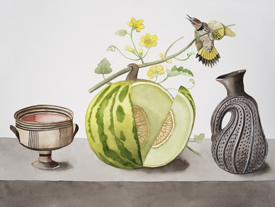 Sue Johnson, Uncontained. 2011, watercolor on paper, 22 x 30 in. (artwork © Sue Johnson)
Sue Johnson, Uncontained. 2011, watercolor on paper, 22 x 30 in. (artwork © Sue Johnson)
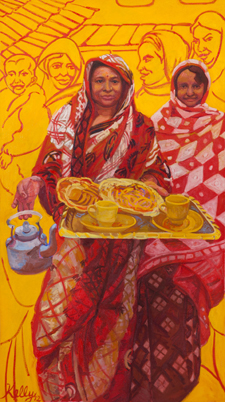 Joan Marie Kelly, Kolkata’s Welcome, 2012, oil on canvas, 60 x 34 in. (artwork © Joan Marie Kelly)
Joan Marie Kelly, Kolkata’s Welcome, 2012, oil on canvas, 60 x 34 in. (artwork © Joan Marie Kelly)
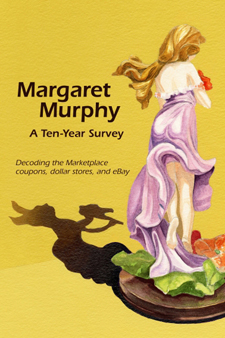 Invitation card for Margaret Murphy, A Ten-Year Survey
Invitation card for Margaret Murphy, A Ten-Year Survey

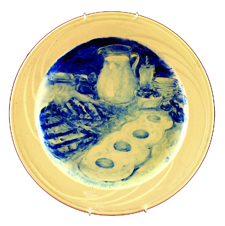 Julie Green, Texas 15 June 2010 Four eggs, four chicken drumsticks, salsa, four jalapeno peppers, lettuce, tortillas, hashbrowns, garlic bread, two pork chops, white and yellow grated cheese, sliced onions and tomatoes, a pitcher of milk and a vanilla shake, 2011, cobalt blue mineral paint kiln fired on 12-inch ceramic plate (artwork © Julie Green)
Julie Green, Texas 15 June 2010 Four eggs, four chicken drumsticks, salsa, four jalapeno peppers, lettuce, tortillas, hashbrowns, garlic bread, two pork chops, white and yellow grated cheese, sliced onions and tomatoes, a pitcher of milk and a vanilla shake, 2011, cobalt blue mineral paint kiln fired on 12-inch ceramic plate (artwork © Julie Green)
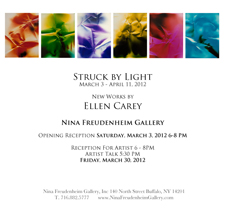 Invitation card for Ellen Carey’s Struck by Light
Invitation card for Ellen Carey’s Struck by Light
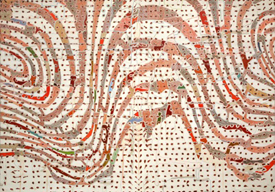 Nayda Collazo-Llorens, Locus Rackets Hypnotic #2 (from the Test Series), 2012, mixed media on canvas, 50 x 70 in. (artwork © Nayda Collazo-Llorens)
Nayda Collazo-Llorens, Locus Rackets Hypnotic #2 (from the Test Series), 2012, mixed media on canvas, 50 x 70 in. (artwork © Nayda Collazo-Llorens)
 Steel sculptures by Janet Goldner (artwork © Janet Goldner)
Steel sculptures by Janet Goldner (artwork © Janet Goldner)
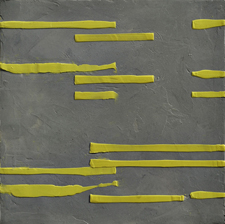 Debra Ramsay, Forgotten Day, 2012, wax on MDF board, 6 x 6 in. (artwork © Debra Ramsay; photograph by Andy Wainwright)
Debra Ramsay, Forgotten Day, 2012, wax on MDF board, 6 x 6 in. (artwork © Debra Ramsay; photograph by Andy Wainwright)
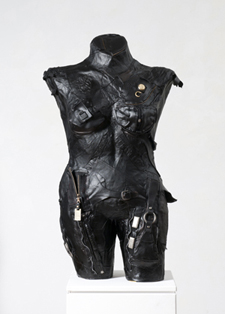 Linda Stein, Justice for All 696, 2010, leather, metal, and mixed media, 38 x 22 x 14 in. (artwork © Linda Stein)
Linda Stein, Justice for All 696, 2010, leather, metal, and mixed media, 38 x 22 x 14 in. (artwork © Linda Stein)
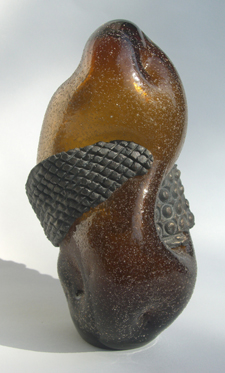 Marianne Weil, Abbraccio, 2011, cast bronze and blown glass, 10 x 6 x 5 in. (artwork © Marianne Weil)
Marianne Weil, Abbraccio, 2011, cast bronze and blown glass, 10 x 6 x 5 in. (artwork © Marianne Weil)
 Leigh-Ann Pahapill, view of the installation Likewise, as technical experts, but not (at all) by way of culture, 2012.
Leigh-Ann Pahapill, view of the installation Likewise, as technical experts, but not (at all) by way of culture, 2012.
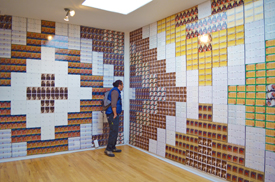 Michael Darmody, installation view of House of Cards, 2012, 3,600 souvenir Indian postcards mounted on foam board squares on four walls of a 12 x 18 x 10 ft. space (artwork © Michael Darmody; photograph by the artist)
Michael Darmody, installation view of House of Cards, 2012, 3,600 souvenir Indian postcards mounted on foam board squares on four walls of a 12 x 18 x 10 ft. space (artwork © Michael Darmody; photograph by the artist)
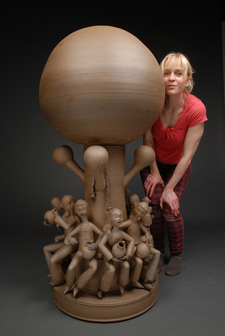 Gerit Grimm, Village Tree, 2011, stoneware, 55 x 23 x 23 in. (artwork © Gerit Grimm; photograph by the artist)
Gerit Grimm, Village Tree, 2011, stoneware, 55 x 23 x 23 in. (artwork © Gerit Grimm; photograph by the artist)
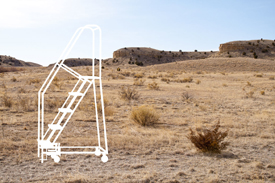 Ellen Mueller, Ladder 1, 2012, digital photograph, 24 x 36 in. (artwork © Ellen Mueller)
Ellen Mueller, Ladder 1, 2012, digital photograph, 24 x 36 in. (artwork © Ellen Mueller)
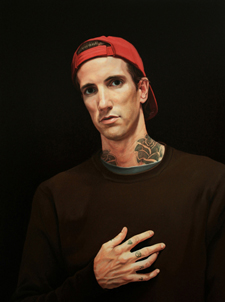 Olga Ponomarenko, Romantic Punk after Botticelli, 2011, oil on canvas, 24 x 18 in. (artwork © Olga Ponomarenko)
Olga Ponomarenko, Romantic Punk after Botticelli, 2011, oil on canvas, 24 x 18 in. (artwork © Olga Ponomarenko)
 Ruth Weisberg, Ravished, 2011, oil and mixed media on unstretched canvas,
Ruth Weisberg, Ravished, 2011, oil and mixed media on unstretched canvas,
 Angela Young, detail of a drawing in Human Nature, 2011, powered graphite and charcoal, 42 x 152 in. (artwork © Angela Young; photograph by the artist)
Angela Young, detail of a drawing in Human Nature, 2011, powered graphite and charcoal, 42 x 152 in. (artwork © Angela Young; photograph by the artist)
 Luba Freedman
Luba Freedman
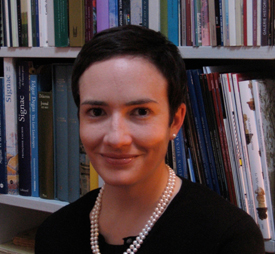 Emily Beeny (photograph provided by the Museum of Fine Arts, Boston)
Emily Beeny (photograph provided by the Museum of Fine Arts, Boston)
 Olivier Meslay (photograph provided by the Dallas Museum of Art)
Olivier Meslay (photograph provided by the Dallas Museum of Art)
 Joanne Pillsbury (photograph provided by Getty Communications)
Joanne Pillsbury (photograph provided by Getty Communications)
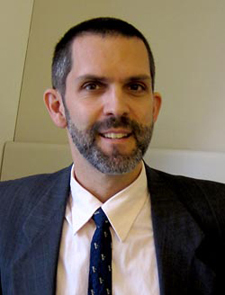 Joel Smith (photograph provided by the Morgan Museum and Library)
Joel Smith (photograph provided by the Morgan Museum and Library)
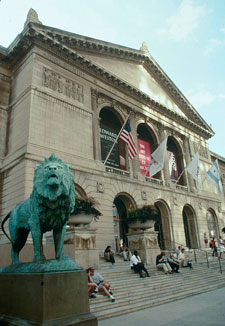 South view of the Michigan Avenue façade of the Art Institute of Chicago (photograph provided by the Art Institute of Chicago)
South view of the Michigan Avenue façade of the Art Institute of Chicago (photograph provided by the Art Institute of Chicago)